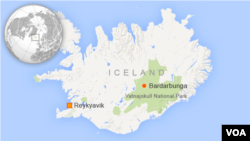Authorities in Iceland have lowered an alert warning that had been raised to its highest level, following a volcanic eruption in a central region.
The country's meteorological institute has lowered the warning code from red to orange -- a move that lifts flight restrictions in the region.
The institute had raised the warning code to red after an eruption at the Bardarbunga volcano.
Authorities later said that no volcanic ash had been detected and the fissure eruption posed no threat to aircraft.
In 2010, an ash cloud from the Eyjafjallajokull volcano, in a different region of Iceland, closed much of Europe's air space for six days.
Iceland's largest volcanic system, which cuts a 190-km (118-mile)-long and up to 25-km-(15.5-mile)-wide swathe across the North Atlantic island, has been hit by thousands of earthquakes over the last two weeks and scientists have been on high alert in case of an eruption.
Reykjavik's Meteorological Office said that just after midnight an estimated 1-km-long fissure eruption began in a lava field north of the Vatnajokull glacier, which covers part of Bardarbunga system.
The eruption is at the tip of a magma dyke around 40 km from the main Bardarbunga crater and activity subsided to relatively low levels after peaking between 0020 and 0200 GMT, Iceland Met Office seismologist Martin Hensch said.
He said that it was impossible to say how the eruption would develop.
“One of the concerns is that the fissure opens into the glacier but presently there is no sign of that happening,” he said, adding that the eruption was 6-8 km from the glacier.
Nick Petford, a vulcanology expert at the University of Northampton in Britain, said fissure eruptions were often spectacular, but relatively low key and often died out in a couple of days.
The Eyjafjallajokull eruption was particularly disruptive because it pushed ash up to just the elevation used by transatlantic aircraft, while prevailing winds propelled the cloud into European air space. The ash was also particularly sticky due to its chemical composition.
Petford said that if the current eruption subsided, scientists would be looking for signs of more quakes deeper under the volcano, which would suggest more magma was welling up, and for any swelling of the volcano that could be measured using GPS.
Some information for this report provided by Reuters.







